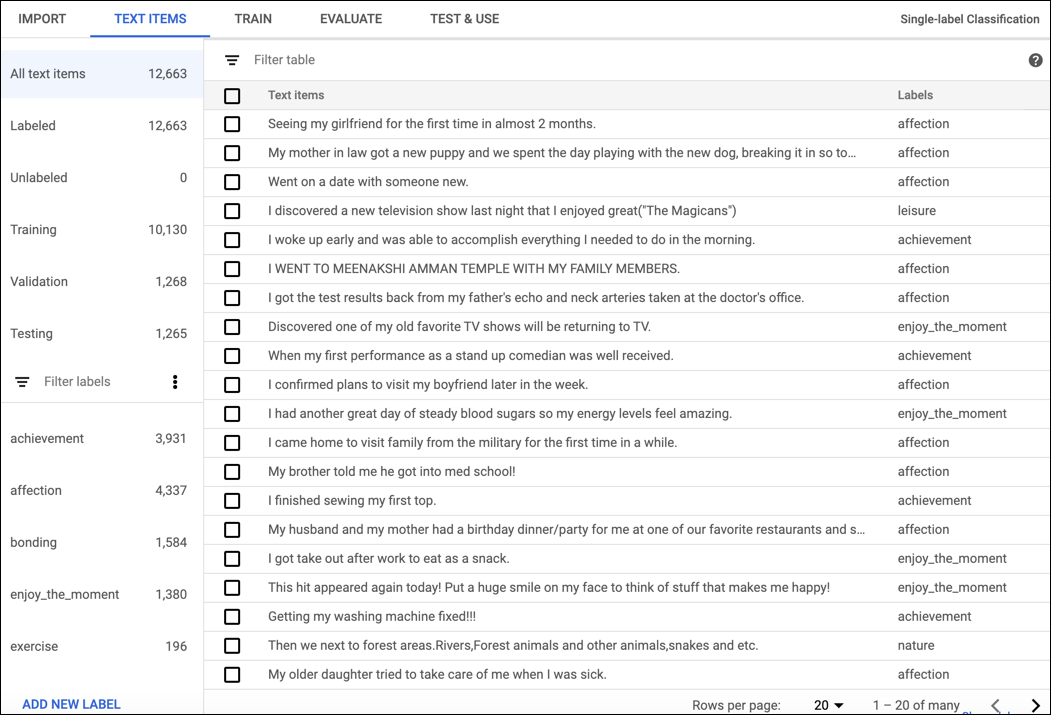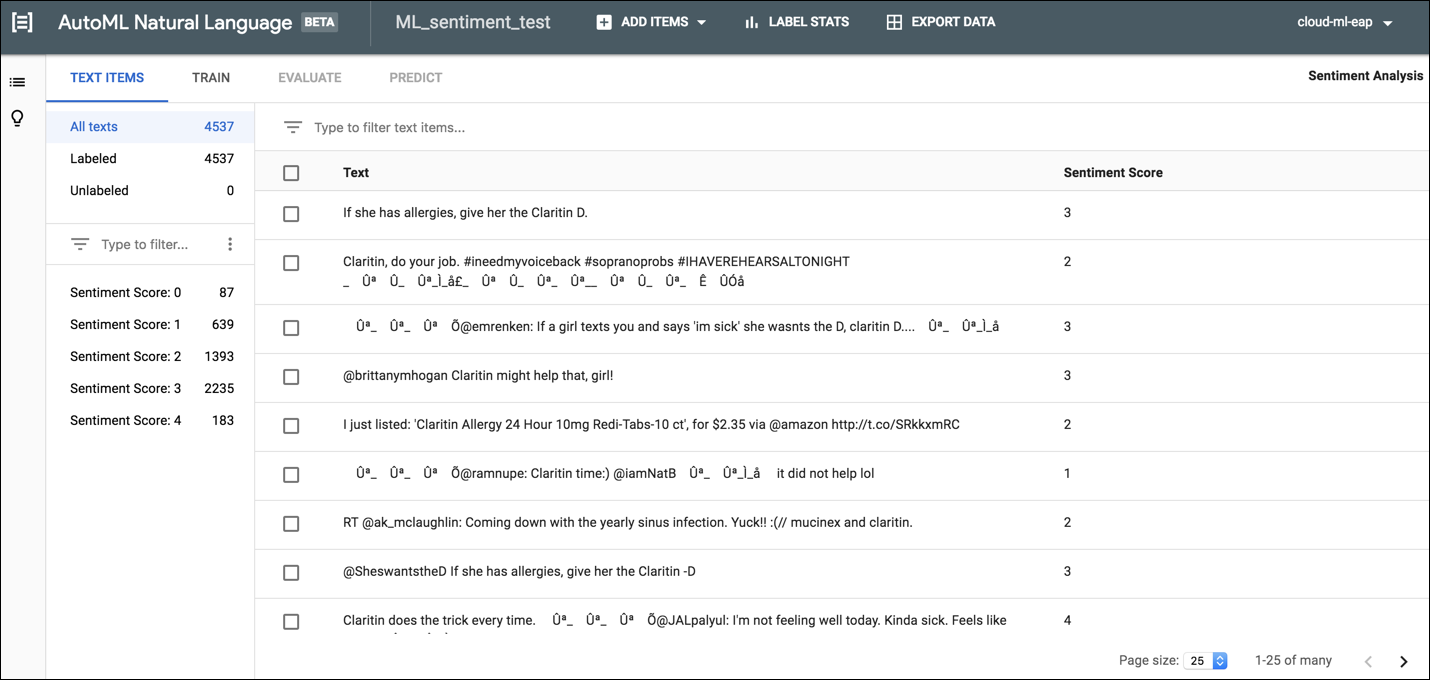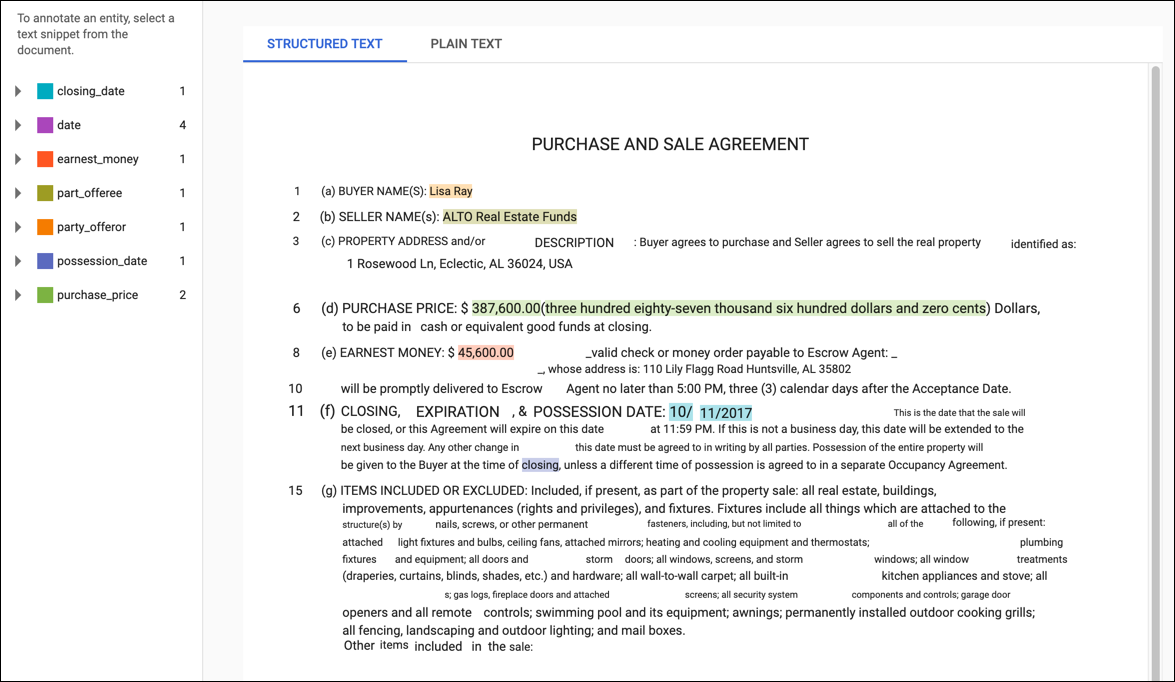数据集包含要分类的各种内容的代表性样本,采用您希望自定义模型使用的类别标签进行标记。数据集用作训练模型的输入。
构建数据集的主要步骤如下:
对于分类和情感分析,第 2 步和第 3 步通常合并完成:您可以导入已分配标签的文档。
创建数据集
如要创建自定义模型,首先需要创建一个空数据集,该数据集最终用于保存模型的训练数据。在您导入文档之前,新创建的数据集不包含任何数据。
网页界面
要创建数据集,请执行以下操作:
打开 AutoML Natural Language 界面,然后在与您计划训练的模型类型对应的框中选择开始使用。
此时会出现数据集页面,其中显示了之前为当前项目创建的数据集的状态。
如需为其他项目添加数据集,请从标题栏右上角的下拉列表中选择项目。
点击标题栏中的新建数据集按钮。
输入数据集的名称,然后指定要在其中存储数据集的地理位置。
如需了解详情,请参阅位置。
选择模型目标,该目标指定您将借助模型(您使用此数据集训练的模型)执行的分析类型。
- 单标签分类为每个分类的文档分配一个标签
- 多标签分类可以为某个文档分配多个标签
- 实体提取识别文档中的实体
- 情感分析可以分析文档中的态度
点击创建数据集。
此时会出现新数据集的导入页面。 请参阅将数据导入到数据集中。
代码示例
分类
REST
在使用任何请求数据之前,请先进行以下替换:
- project-id:您的项目 ID
- location-id:资源的位置,全球位置为
us-central1,欧盟位置为eu
HTTP 方法和网址:
POST https://automl.googleapis.com/v1/projects/project-id/locations/location-id/datasets
请求 JSON 正文:
{
"displayName": "test_dataset",
"textClassificationDatasetMetadata": {
"classificationType": "MULTICLASS"
}
}
如需发送您的请求,请展开以下选项之一:
您应该收到类似以下内容的 JSON 响应:
{
"name": "projects/434039606874/locations/us-central1/datasets/356587829854924648",
"displayName": "test_dataset",
"createTime": "2018-04-26T18:02:59.825060Z",
"textClassificationDatasetMetadata": {
"classificationType": "MULTICLASS"
}
}
Python
如需了解如何安装和使用 AutoML Natural Language 的客户端库,请参阅 AutoML Natural Language 客户端库。 有关详情,请参阅 AutoML Natural Language Python API 参考文档。
如需向 AutoML Natural Language 进行身份验证,请设置应用默认凭据。如需了解详情,请参阅为本地开发环境设置身份验证。
Java
如需了解如何安装和使用 AutoML Natural Language 的客户端库,请参阅 AutoML Natural Language 客户端库。 有关详情,请参阅 AutoML Natural Language Java API 参考文档。
如需向 AutoML Natural Language 进行身份验证,请设置应用默认凭据。如需了解详情,请参阅为本地开发环境设置身份验证。
Node.js
如需了解如何安装和使用 AutoML Natural Language 的客户端库,请参阅 AutoML Natural Language 客户端库。 有关详情,请参阅 AutoML Natural Language Node.js API 参考文档。
如需向 AutoML Natural Language 进行身份验证,请设置应用默认凭据。如需了解详情,请参阅为本地开发环境设置身份验证。
Go
如需了解如何安装和使用 AutoML Natural Language 的客户端库,请参阅 AutoML Natural Language 客户端库。 有关详情,请参阅 AutoML Natural Language Go API 参考文档。
如需向 AutoML Natural Language 进行身份验证,请设置应用默认凭据。如需了解详情,请参阅为本地开发环境设置身份验证。
其他语言
C#: 请遵循 C# 设置说明 在客户端库页面上 然后访问 适用于 .NET 的 AutoML Natural Language 参考文档。
PHP: 请遵循 PHP 设置说明 在客户端库页面上 然后访问 适用于 PHP 的 AutoML Natural Language 参考文档。
Ruby: 请遵循 Ruby 设置说明 在客户端库页面上 然后访问 Ruby 版 AutoML Natural Language 参考文档。
实体提取
REST
在使用任何请求数据之前,请先进行以下替换:
- project-id:您的项目 ID
- location-id:资源的位置,全球位置为
us-central1,欧盟位置为eu
HTTP 方法和网址:
POST https://automl.googleapis.com/v1/projects/project-id/locations/location-id/datasets
请求 JSON 正文:
{
"displayName": "test_dataset",
"textExtractionDatasetMetadata": {
}
}
如需发送您的请求,请展开以下选项之一:
您应该收到类似以下内容的 JSON 响应:
{
name: "projects/000000000000/locations/us-central1/datasets/TEN5582774688079151104"
display_name: "test_dataset"
create_time {
seconds: 1539886451
nanos: 757650000
}
text_extraction_dataset_metadata {
}
}
Python
如需了解如何安装和使用 AutoML Natural Language 的客户端库,请参阅 AutoML Natural Language 客户端库。 有关详情,请参阅 AutoML Natural Language Python API 参考文档。
如需向 AutoML Natural Language 进行身份验证,请设置应用默认凭据。如需了解详情,请参阅为本地开发环境设置身份验证。
Java
如需了解如何安装和使用 AutoML Natural Language 的客户端库,请参阅 AutoML Natural Language 客户端库。 有关详情,请参阅 AutoML Natural Language Java API 参考文档。
如需向 AutoML Natural Language 进行身份验证,请设置应用默认凭据。如需了解详情,请参阅为本地开发环境设置身份验证。
Node.js
如需了解如何安装和使用 AutoML Natural Language 的客户端库,请参阅 AutoML Natural Language 客户端库。 有关详情,请参阅 AutoML Natural Language Node.js API 参考文档。
如需向 AutoML Natural Language 进行身份验证,请设置应用默认凭据。如需了解详情,请参阅为本地开发环境设置身份验证。
Go
如需了解如何安装和使用 AutoML Natural Language 的客户端库,请参阅 AutoML Natural Language 客户端库。 有关详情,请参阅 AutoML Natural Language Go API 参考文档。
如需向 AutoML Natural Language 进行身份验证,请设置应用默认凭据。如需了解详情,请参阅为本地开发环境设置身份验证。
其他语言
C#: 请遵循 C# 设置说明 在客户端库页面上 然后访问 适用于 .NET 的 AutoML Natural Language 参考文档。
PHP: 请遵循 PHP 设置说明 在客户端库页面上 然后访问 适用于 PHP 的 AutoML Natural Language 参考文档。
Ruby: 请遵循 Ruby 设置说明 在客户端库页面上 然后访问 Ruby 版 AutoML Natural Language 参考文档。
情感分析
REST
在使用任何请求数据之前,请先进行以下替换:
- project-id:您的项目 ID
- location-id:资源的位置,全球位置为
us-central1,欧盟位置为eu
HTTP 方法和网址:
POST https://automl.googleapis.com/v1/projects/project-id/locations/location-id/datasets
请求 JSON 正文:
{
"displayName": "test_dataset",
"textSentimentDatasetMetadata": {
"sentimentMax": 4
}
}
如需发送您的请求,请展开以下选项之一:
您应该收到类似以下内容的 JSON 响应:
{
name: "projects/000000000000/locations/us-central1/datasets/TST8962998974766436002"
display_name: "test_dataset_name"
create_time {
seconds: 1538855662
nanos: 51542000
}
text_sentiment_dataset_metadata {
sentiment_max: 7
}
}
Python
如需了解如何安装和使用 AutoML Natural Language 的客户端库,请参阅 AutoML Natural Language 客户端库。 有关详情,请参阅 AutoML Natural Language Python API 参考文档。
如需向 AutoML Natural Language 进行身份验证,请设置应用默认凭据。如需了解详情,请参阅为本地开发环境设置身份验证。
Java
如需了解如何安装和使用 AutoML Natural Language 的客户端库,请参阅 AutoML Natural Language 客户端库。 有关详情,请参阅 AutoML Natural Language Java API 参考文档。
如需向 AutoML Natural Language 进行身份验证,请设置应用默认凭据。如需了解详情,请参阅为本地开发环境设置身份验证。
Node.js
如需了解如何安装和使用 AutoML Natural Language 的客户端库,请参阅 AutoML Natural Language 客户端库。 有关详情,请参阅 AutoML Natural Language Node.js API 参考文档。
如需向 AutoML Natural Language 进行身份验证,请设置应用默认凭据。如需了解详情,请参阅为本地开发环境设置身份验证。
Go
如需了解如何安装和使用 AutoML Natural Language 的客户端库,请参阅 AutoML Natural Language 客户端库。 有关详情,请参阅 AutoML Natural Language Go API 参考文档。
如需向 AutoML Natural Language 进行身份验证,请设置应用默认凭据。如需了解详情,请参阅为本地开发环境设置身份验证。
其他语言
C#: 请遵循 C# 设置说明 在客户端库页面上 然后访问 适用于 .NET 的 AutoML Natural Language 参考文档。
PHP: 请遵循 PHP 设置说明 在客户端库页面上 然后访问 适用于 PHP 的 AutoML Natural Language 参考文档。
Ruby: 请遵循 Ruby 设置说明 在客户端库页面上 然后访问 Ruby 版 AutoML Natural Language 参考文档。
将训练数据导入数据集
创建数据集后,您可以从 Cloud Storage 存储分区中存储的 CSV 文件导入文档 URI 和文档标签。如需详细了解如何准备数据并创建 CSV 文件以供导入,请参阅准备训练数据。
您可以将文档导入到空数据集中,也可以将其他文档导入到现有数据集中。
网页界面
如需将文档导入到数据集中,请执行以下操作:
从数据集页面选择要向其中导入文档的数据集。
在导入标签页上,指定查找训练文档的位置。
您可以:
从本地计算机或 Cloud Storage 上传包含培训文档及其相关类别标签的.csv 文件。
从本地计算机上传一个包含训练文档的 .txt、.pdf、tif 或 .zip 文件集合。
选择要导入的文件以及导入文档的 Cloud Storage 路径。
点击导入。
代码示例
REST
在使用任何请求数据之前,请先进行以下替换:
- project-id:您的项目 ID
- location-id:资源的位置,全球位置为
us-central1,欧盟位置为eu - dataset-id:您的数据集 ID
- bucket-name:您的 Cloud Storage 存储分区
- csv-file-name:您的 CSV 训练数据文件
HTTP 方法和网址:
POST https://automl.googleapis.com/v1/projects/project-id/locations/location-id/datasets/dataset-id:importData
请求 JSON 正文:
{
"inputConfig": {
"gcsSource": {
"inputUris": ["gs://bucket-name/csv-file-name.csv"]
}
}
}
如需发送您的请求,请展开以下选项之一:
您应该会看到类似如下所示的输出。可以使用操作 ID 来获取任务的状态。如需示例,请参阅获取操作状态。
{
"name": "projects/434039606874/locations/us-central1/operations/1979469554520650937",
"metadata": {
"@type": "type.googleapis.com/google.cloud.automl.v1beta1.OperationMetadata",
"createTime": "2018-04-27T01:28:36.128120Z",
"updateTime": "2018-04-27T01:28:36.128150Z",
"cancellable": true
}
}
Python
如需了解如何安装和使用 AutoML Natural Language 的客户端库,请参阅 AutoML Natural Language 客户端库。 有关详情,请参阅 AutoML Natural Language Python API 参考文档。
如需向 AutoML Natural Language 进行身份验证,请设置应用默认凭据。如需了解详情,请参阅为本地开发环境设置身份验证。
Java
如需了解如何安装和使用 AutoML Natural Language 的客户端库,请参阅 AutoML Natural Language 客户端库。 有关详情,请参阅 AutoML Natural Language Java API 参考文档。
如需向 AutoML Natural Language 进行身份验证,请设置应用默认凭据。如需了解详情,请参阅为本地开发环境设置身份验证。
Node.js
如需了解如何安装和使用 AutoML Natural Language 的客户端库,请参阅 AutoML Natural Language 客户端库。 有关详情,请参阅 AutoML Natural Language Node.js API 参考文档。
如需向 AutoML Natural Language 进行身份验证,请设置应用默认凭据。如需了解详情,请参阅为本地开发环境设置身份验证。
Go
如需了解如何安装和使用 AutoML Natural Language 的客户端库,请参阅 AutoML Natural Language 客户端库。 有关详情,请参阅 AutoML Natural Language Go API 参考文档。
如需向 AutoML Natural Language 进行身份验证,请设置应用默认凭据。如需了解详情,请参阅为本地开发环境设置身份验证。
其他语言
C#: 请遵循 C# 设置说明 在客户端库页面上 然后访问 适用于 .NET 的 AutoML Natural Language 参考文档。
PHP: 请遵循 PHP 设置说明 在客户端库页面上 然后访问 适用于 PHP 的 AutoML Natural Language 参考文档。
Ruby: 请遵循 Ruby 设置说明 在客户端库页面上 然后访问 Ruby 版 AutoML Natural Language 参考文档。
为训练文档添加标签
为了有助于训练模型,数据集中的每个文档都必须添加标签,添加的方式与您希望 AutoML Natural Language 为类似文档添加标签的方式相同。训练数据的质量极大影响着所创建的模型的效果,进而影响该模型返回的预测结果的质量。AutoML Natural Language 会在训练期间忽略未添加标签的文档。
您可以通过以下三种方式为训练文档提供标签:
- 将标签添加到 .csv 文件中(仅针对分类和情感分析)
- 在 AutoML Natural Language 界面中为文档添加标签
- 使用 AI Platform 数据标签服务请求人工标签添加者添加标签
AutoML API 无法执行添加标签的操作。
如需详细了解如何为 .csv 文件中的文档添加标签,请参阅准备训练数据。
针对分类和情感分析添加标签
如需在 AutoML Natural Language 界面中为文档添加标签,请从数据集列表页面中选择相应数据集以查看其详细信息。所选数据集的显示名会显示在标题栏中,该页面还会列出数据集中的各个文档及其当前的标签。左侧导航栏汇总了已加标签和未加标签的文档数,使您可以按标签或情感值过滤文档列表。


如需为未加标签的文档分配标签或情感值,或者更改文档标签,请选择要更新的文档以及要为其分配的标签或情感值。您可以通过以下两种方式更新文档的标签:
点击要更新的文档旁边的复选框,然后从文档列表顶部显示的标签下拉列表中选择要应用的标签。
点击要更新的文档所在的行,然后从文本详细信息 (Text detail) 页面上显示的列表中选择要应用的标签或情感值。
为实体提取标识实体
在训练自定义模型之前,您需要为数据集中的训练文档添加注释。 您可以在导入训练文档之前为其添加注释,也可以在 AutoML Natural Language 界面中添加注释。
如需在 AutoML Natural Language 界面中添加注释,请从数据集列表页面中选择相应数据集以查看其详细信息。所选数据集的显示名会显示在标题栏中,该页面还会列出数据集中的各个文档及其所有注释。左侧导航栏汇总了标签以及每个标签的显示次数。您还可以按标签过滤文档列表。

如需在文档中添加注释或者从文档中删除注释,请双击要更新的文档。修改页面会显示所选文档的完整文本,并突出显示之前的所有注释。

对于 PDF 训练文档或导入时带有布局信息的文档,修改页面有两个标签页:纯文本和结构化文本。纯文本标签页会显示训练文档的原始内容,不带任何格式。结构化文本标签页会重新创建训练文档的基本布局。 (纯文本标签页还包含指向原始 PDF 文件的链接。)

如需添加新注释,请突出显示代表实体的文本,再从添加注释对话框中选择标签,然后点击保存。当您在结构化文本标签页上添加注释时,AutoML Natural Language 会获取注释在页面上的位置以作为训练时考虑的一个因素。

如需移除注释,请在右侧的标签列表中找到相应文本,然后点击旁边的垃圾桶图标。

